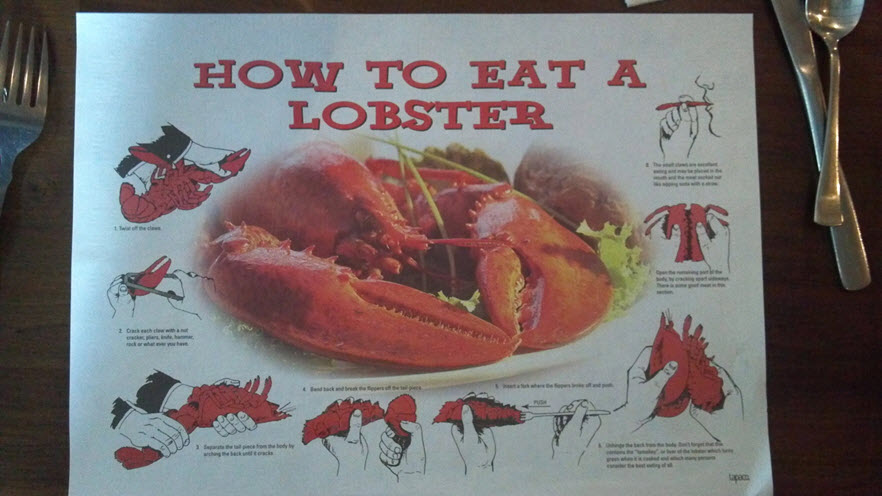Content Marketing: Encouraging sales and upsells at the point of purchase
Many marketers think of content marketing as a top-of-the-funnel activity. This could include a video to build brand awareness, or an e-book to grow the email list.
But what about using content to encourage sales and upsells at the point of purchase?
On a recent trip to Maine, I came across a great example of point-of-purchase content marketing, although I’m not sure the content’s author would have labeled it as such.
How to eat a lobster
This is a great example of where point-of-purchase content marketing can help: when you have a product that novice customers might not know how to use.
For a tourist who has never eaten a lobster, a placemat like this could be the tipping point between:
- Buying the less expensive (and easier to eat) lobster roll or lobster meat salad or something more familiar like a steak
or
- Buying the premium-priced product with the higher margin – lobster
No one wants to order a lobster (or any product) and look like a fool because they don’t know how to eat it. They are less likely to order because they don’t see the value in it.
That’s why this placemat is true content marketing, by my definition. This isn’t an overt sales piece; it was executed in a way that teaches someone how to do something.
Even for myself, as I have eaten a lobster before and was going to order one anyway, it helped me enjoy it more as a refresher for exactly how to eat the lobster since it had been a few years since I’ve eaten one.
Opportunities for point-of-purchase content marketing
The great opportunity for point-of-purchase content marketing is this:
When a customer needs to be taught about the product to make a
decision that is better for them.
This likely falls into two major buckets: product education and product differentiation.
Product Education: Using content marketing to teach customers how to use the product
There are many reasons customers may want to use a product, but have to overcome the friction and anxiety of being unsure how to use it:
- Cultural – Tourists are a great example of this. “How to eat a lobster” in Maine. But also “how to hail a cab” in New York City or “how to order sushi” in San Francisco.
- New – You can encourage early adopters and even laggards by showing them how to do things in a new way, along with the value prop of doing it. Examples might include making a payment with a smartphone or using a car hailing app instead of hailing that cab on the street.
- Rules-based – You may be selling something that relates to a game or hobby that they simply haven’t tried yet. Many gambling games are a great example. A simple sign or video in a casino might encourage more people to try their luck. Or if it’s a hobby, a magazine about archery next to an archery display in a store might convince shoppers to take the plunge and try it.
- Too cool – How do you order a hand-crafted cocktail in a hipster bar and look like you fit in? When you think about it, this is the main reason behind the sommelier – a great example of content marketing that encourages a larger purchase and helps people understand and enjoy the purchase more.
Product Differentiation: Choice is required
Sometimes shoppers are sold on buying the product, but they are unsure which option to choose. The $20, $40 or $60 option. The tablet with Wi-Fi or Wi-Fi and 4G. Silver, gold or platinum. A, B or C package.
Content marketing can help introduce and explain why there are different options, and which customers are a best fit for various levels of offerings.
Content Lobster
Like the B-52’s “Rock Lobster,” perhaps the Content Lobster can serve as a reminder to take a good, hard look at what your customers experience at the point of purchase – both online and in the real world – and question if content can help them make better choices.
You may also like
Content Marketing: User-generated content tips from Jimmy Wales of Wikipedia [More from the blogs]
2 Tough Questions to Ask About Your Content Marketing Strategy [More form the blogs]
Content Marketing: Come in with an idea, leave with a blog post [More form the blogs]
Categories: Marketing advertising, content marketing, ecommerce, marketing strategy, upsells, Value Proposition











Such a great way of looking at content marketing, such an interesting point of view – thanks, Daniel!